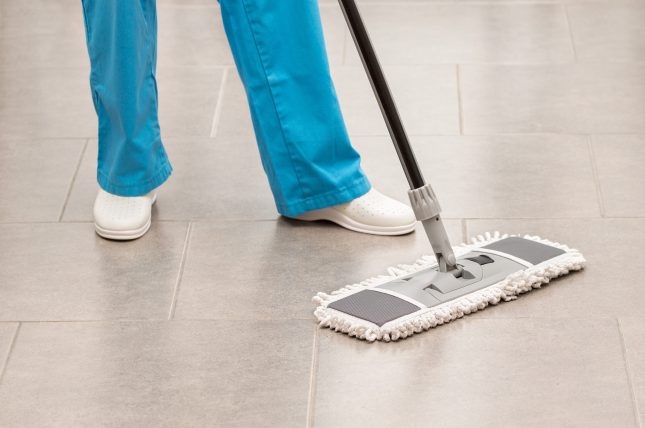
In every healthcare setting, infection prevention is the game within the game. It’s the ever-present battle threatening to undermine patient outcomes, regardless of the problem a patient presented with in the first place.
Too often, healthcare providers are losing. Healthcare-associated infections (HAIs) impact more than a million people every year, resulting in 99,000 annual patient deaths and billions of dollars in added costs for healthcare providers.
These pathogens come from various sources, but one place that’s often overlooked is the floor, a ubiquitous surface area contacted by patients, hospital personnel, and equipment.
Floors Are a Breeding Ground for Bacteria
Cleaning and disinfection are two different objectives, and failing to disinfect or disinfecting with the wrong solution often results in pathogens merely being moved around from one location to another or viruses, like C-Auris “shedding,” making every surface a potential infection point. Since hospital floors are frequently cleaned but rarely disinfected, or disinfected with ineffective methods, they are a breeding ground for bacteria.
According to one study conducted by researchers with the Northeast Ohio VA Healthcare System, hospital floors are a “hotspot for bacteria to breed.” In the study, all spaces were thoroughly cleaned and sanitized, and all patients tested negative for methicillin-resistant Staphylococcus aureus (MRSA) and other healthcare-associated bacteria before entering the testing area.
However, half the rooms tested positive for MRSA within the first 24 hours, and 58 percent were contaminated within four days of patient admission. The journey from floor to patient started from the ground up. Patients’ socks picked up pathogens on the floors before moving to the bedding and other nearby surfaces.
The spread occurs more rapidly and broadly once pathogens move from the floor to treatment spaces. A separate study, which intentionally seeded a space with non-pathogenic viruses to track their movement, found that viruses can move from floors to hand areas, exacerbating transfer within the room and in other rooms throughout the same ward.
Similarly, a survey of five hospitals found that “floors in patient rooms were frequently contaminated with pathogens and high-touch objects such as blood pressure cuffs and call buttons were often in contact with the floor.”
This isn’t new information. A 2014 study by Open Forum Infectious Diseases concluded, “Hospital floors are frequently contaminated with pathogens and often contacted by high-touch objects. Hospital floors could be an underappreciated reservoir for transmission of healthcare-associated pathogens.”
However, burdened by high staff turnover, ineffective manual processes, and quality control challenges, many hospitals and healthcare facilities have been unable to address this challenge effectively, despite their best efforts.
Using automated disinfection with a credible disinfectant can reverse this trend by disinfecting floors and other surfaces without inundating EVS or medical teams with additional responsibilities or concerns. The results can be incredible for patients and healthcare providers.
How Nimbus Helps Prevent Pathogen Transfer on Floors
Nimbus, Nevoa’s whole-room fogging technology, is the only patented, hospital-grade surface disinfecting system approved for fogging with EPA-registered hypochlorous acid (HOCl). Nimbus offers several disinfection benefits, including:
- Reaching 100% of surfaces, including floors and room air
- Immediate room re-entry
- Zero pathogen transfer and human variability
- Delivers LOG 4-6 EPA registered efficacy
- Cloud-based data and reporting
For healthcare providers, Nimbus is a proven disinfection solution that eradicates pathogens on every room surface, including floors, without introducing additional workflows for EVS teams or medical staff.
This was evidenced recently when an acute care facility deployed Nimbus to mitigate pathogen transfer. The facility sought to understand how Nimbus would impact room disinfection with the specific goal of measuring pathogen transfer from floor spaces.
The study found that room Aerobic Colony counts exceeded 190 as a baseline average. The number fell to 104.9 after manual cleaning with a quaternary-based disinfectant cleaner but plummeted to just 8.5 after Nimbus was used to disinfect a treatment space. Put differently, manual cleaning eradicated less than 45 percent of pathogens, while Nimbus eliminated nearly 96 percent.
The study showed that Nimbus effectively combats the prevalent issue of pathogen transfer on floors, ensuring a significantly higher disinfection level than traditional manual cleaning methods. It also achieved this without leaving a sticky residue, which is common when quat-based floor disinfectants are used. Perhaps most importantly, it’s a replicable success rate that can also positively impact your treatment space.
If You Suspect Floor Pathogen Transfer is a Problem, Nimbus is Your Solution
Traditionally, floors have been classified as non-critical surfaces because they are often only contacted by footwear and intact skin. Now we know better. If HAIs are a problem at your healthcare facility, accounting for the floors might be the next step toward effective whole-room disinfection.
Fortunately, this doesn’t have to mean more work for your teams or more money from your budget. Nimbus offers an effective, affordable, and automated disinfection solution that kills pathogens on every surface area, reducing the risk that patients contract an HAI at your facility.
Contact our team today. We are available to answer any questions or demonstrate Nimbus in action.
